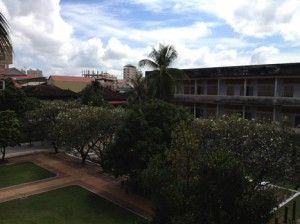Oct. 31 started very early for those of us in the Shanghai program, but no one complained. At 3:30 a.m. we stumbled half-awake on to the bus that was to take us to Pudong airport and eventually to Cambodia. Now I’ll be the first to admit that I knew nothing about what Cambodia had to offer. I knew little about its history or culture and even less about its geography. I placed my complete trust in the program office and blindly boarded the plane. The first thing we noticed when we arrived was the heat. It was humid and nearly 90 degrees. There were enormous bugs and lizards everywhere. After clearing customs, we boarded a tour bus to our hotel. It was impossible to miss the overwhelming poverty that flashed by our windows. There were few cars on the streets. Taxis were non-existent. Instead there are took-tooks, rickshaws pulled by men on bicycles. Later we would learn that a vast majority of the county lives without basic infrastructure. No water, no paved roads, no electricity. The country’s number-one industry is tourism.
Phnom Penh is the capitol of Cambodia. It is centered on the Mekong River and has a population of about 2.2 million people. To give some perspective, Cambodia’s entire population is only about 14.8 million people. Phenom Penh feels a bit like an overturned anthill.

The next morning dawned, hot and sticky. We toured all day, taking in the national palace, S21 prison and the killing fields. As we toured, we learned about Cambodia’s recent, and very tragic history. The genocide carried out by the Khmer Rouge only just ended in 1797, so the pain is still very fresh. The S21 prison was horrifying. We saw cells which once held political prisoners and torture devices. Perhaps the most disturbing image was the thousands of photos of victims and their handwritten letters. At the exit was one of only three men to have survived the prison; he signed books and took pictures with our group.
In case we didn’t already have enough to ponder, our next stop was the killing fields. This was essentially an enormous mass grave where nearly 9,000 people were interred. Killing fields can be found across Cambodia, but this one, which sits about 17 kilometers outside of the city, is the largest.
The killing field is not for the faint of heart, and even some of our group chose to remain behind on the bus. Bone shards and pieces of the victims’ clothing still litter the area. In the United States, a sight such as this would be heavily protected and regulated. However, here we were allowed to walk among the open graves, with bone shards just inches from our feet. The whole experience was disturbing. At first I was angry that we had been brought here. Why was it necessary that we see such carnage? Looking back now, I understand. Though it may be a cliché, it is necessary to understand the events of history so as not to repeat them. I know now that my peers and myself will fight tooth and nail against genocide because we have seen its effects firsthand. Yes, the images were disturbing, but I will remain forever changed by what I witnessed in Phenom Penh.
Our second day of touring dawned just as hot and sticky as the day previous. We were still shaken by the images of yesterday’s adventures and the group remained relatively quiet and pensive. Our second day of touring was devoted to understanding Cambodia’s current issues by meeting with the volunteers of International Justice Mission and touring a rehabilitation program called Bloom Café. At IJM we learned about the widespread issue of human trafficking. We learned how girls are forced into the sex trade by their captors or out of desperation to escape the devastating poverty gripping the country. IJM in Cambodia has particularly dedicated themselves to rescuing minors from brothels across the country. They act as legal counsel for women and girls who have been rescued, as well as lobbyists to the Cambodian government for stricter legal sanctions against human trafficking and prostitution. They have been highly successful in persuading the Cambodian government to adopt new, stricter legislation, but there is still much more work to be done. If you would like to get involved with this wonderful organization, please check it out at www.ijm.org.

After our tour of the IJM offices, we set out for Bloom Café, one of the numerous organizations that help to rehabilitate female victims of human trafficking. Bloom Café helps women to get an education and to learn the trade of baking. They make some awe-inspiring edible creations. We sampled their work (which was delicious) and learned a bit about the program. Bloom works closely with IJM, so their goals and philosophy were very similar. After finishing up at Bloom we boarded the bus again for an 8-hour trip to Seim Reip, where we would learn about Cambodia’s ancient history…

